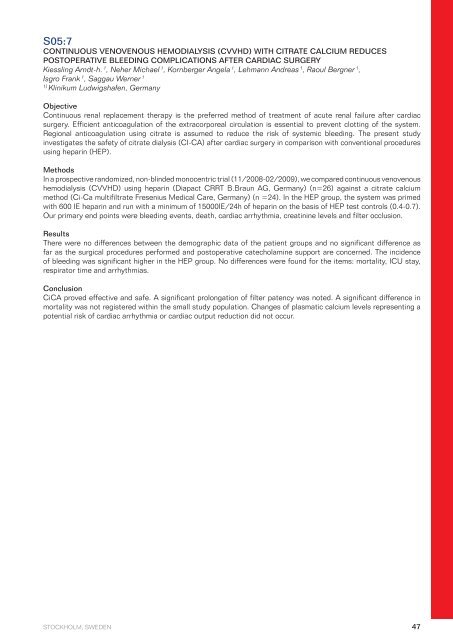SATS 2009 Final Program - Scandinavian Association for Thoracic ...
SATS 2009 Final Program - Scandinavian Association for Thoracic ...
SATS 2009 Final Program - Scandinavian Association for Thoracic ...
You also want an ePaper? Increase the reach of your titles
YUMPU automatically turns print PDFs into web optimized ePapers that Google loves.
S05:7<br />
CONTINUOUS VENOVENOUS HEMODIALYSIS (CVVHD) WITH CITRATE CALCIUM REDUCES<br />
POSTOPERATIVE BLEEDING COMPLICATIONS AFTER CARDIAC SURGERY<br />
Kiessling Arndt-h. 1 , Neher Michael 1 , Kornberger Angela 1 , Lehmann Andreas 1 , Raoul Bergner 1 ,<br />
Isgro Frank 1 , Saggau Werner 1<br />
1) Klinikum Ludwigshafen, Germany<br />
Objective<br />
Continuous renal replacement therapy is the preferred method of treatment of acute renal failure after cardiac<br />
surgery. Efficient anticoagulation of the extracorporeal circulation is essential to prevent clotting of the system.<br />
Regional anticoagulation using citrate is assumed to reduce the risk of systemic bleeding. The present study<br />
investigates the safety of citrate dialysis (CI-CA) after cardiac surgery in comparison with conventional procedures<br />
using heparin (HEP).<br />
Methods<br />
In a prospective randomized, non-blinded monocentric trial (11/2008-02/<strong>2009</strong>), we compared continuous venovenous<br />
hemodialysis (CVVHD) using heparin (Diapact CRRT B.Braun AG, Germany) (n=26) against a citrate calcium<br />
method (Ci-Ca multifiltrate Fresenius Medical Care, Germany) (n =24). In the HEP group, the system was primed<br />
with 600 IE heparin and run with a minimum of 15000IE/24h of heparin on the basis of HEP test controls (0.4-0.7).<br />
Our primary end points were bleeding events, death, cardiac arrhythmia, creatinine levels and filter occlusion.<br />
Results<br />
There were no differences between the demographic data of the patient groups and no significant difference as<br />
far as the surgical procedures per<strong>for</strong>med and postoperative catecholamine support are concerned. The incidence<br />
of bleeding was significant higher in the HEP group. No differences were found <strong>for</strong> the items: mortality, ICU stay,<br />
respirator time and arrhythmias.<br />
Conclusion<br />
CiCA proved effective and safe. A significant prolongation of filter patency was noted. A significant difference in<br />
mortality was not registered within the small study population. Changes of plasmatic calcium levels representing a<br />
potential risk of cardiac arrhythmia or cardiac output reduction did not occur.<br />
STOCKHOLM, SWEDEN 47


